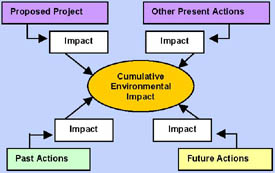















Successes in Stewardship: August 2005 |
|---|

|
Federal Highway Administration
August 2005
New FHWA Workshop Helps Clarify Indirect and Cumulative Impacts

When Federal agencies propose projects or other actions that could affect the quality of the human environment, consideration of direct, indirect, and cumulative impacts (or effects) is required under the National Environmental Policy Act (NEPA). While the direct impacts of a project are more readily understood and relatively easy to predict, indirect and cumulative impacts are often more complicated. There are important differences in the meaning and requirements related to these specific impacts as they arise during the transportation decisionmaking process. A new workshop taught by Federal Highway Administration (FHWA) is helping transportation and resource agencies tackle this challenge by providing a practical understanding, terminology, the requirements, and approaches to successfully addressing these issues.
Direct impacts are caused by the action and occur at the same time and place as the project. Indirect impacts are associated with a project and occur later in time or farther removed in distance; but they are still reasonably foreseeable (e.g., induced land development from highway projects). Cumulative impacts, on the other hand, result from the incremental impacts of the action when added to other past, present, and reasonably foreseeable actions, regardless of the agency or person initiating the other actions. Where indirect impacts are specifically related to a transportation project and can occur from induced development, cumulative impacts are the result of other present and future development actions. Cumulative impacts can also result from individually minor, yet collectively significant, actions taking place over a period of time. (See sidebar for more information.)
The complexities of defining these impacts can make comprehension and analysis of indirect and cumulative impacts a challenge. Every transportation project has a unique set of issues, considerations, and potential influences on the ecology, land, water, air, and the existing communities. The NEPA process can be adapted to address emerging scientific developments and diverse projects. Since 1970, when NEPA was enacted, subsequent judicial decisions have reinforced the requirements of impacts analysis through court findings determining the law as "procedural" rather than "substantive." NEPA requires a "hard look" at probable impacts - direct, indirect, and cumulative — during an agency's decisionmaking process.
The Interagency Task Force established by Executive Order 13274, Environmental Stewardship and Infrastructure Project Reviews, was charged with enhancing environmental stewardship while streamlining the decisionmaking process in connection with major transportation projects. One of its several focus areas is the analysis of indirect and cumulative impacts. A Working Group within the Task Force, comprised of representatives of the U.S. Department of Transportation (DOT), the Council on Environmental Quality, and Federal resource agencies, identified a need to further develop knowledge of and expertise in this area during the NEPA process. The Working Group found that there is minimal national guidance and that training opportunities are limited. Their findings will help to develop goals for ensuring that the relative requirements are given appropriate and adequate treatment in the NEPA process and subsequent environmental documentation. View the Baseline Report prepared by the Working Group.
To help address the needs identified by the Working Group, FHWA is offering a new workshop on indirect and cumulative impacts. The training provides participants with a solid and practical foundation for assessing indirect and cumulative impacts.
|
Cumulative and Indirect Impacts:
What's the Difference? Even seasoned professionals can be confused by the distinction between cumulative and indirect impacts. Here are some simplified definitions of these NEPA terms. For a more detailed explanation, see FHWA's Environmental Guidebook page on indirect and cumulative impacts. Cumulative Impacts are effects on the environment as a result of incremental action when added to other past, present, and reasonably foreseeable future actions, regardless of what agency (Federal or non-Federal) or person undertakes such other actions. Cumulative Impact Diagram:  Indirect Impacts can be considered a subset of cumulative impacts, but are distinguished by an established cause and effect relationship to a proposed action, such as a transportation project. Indirect impacts are often used synonymously with the term "secondary impacts."  |
Other guidance resources include:
The Indirect and Cumulative Impacts Workshops are intended for FHWA Divisions, State DOTs, resource agencies, and contractors/consultants involved in the NEPA and transportation project development process. Participants will gain a better understanding of NEPA requirements and the expectations of indirect and cumulative impact analysis. Workshop curriculum includes the following.
Designed to encourage participation and discussion, the workshops maximize the collective wisdom and experience of participants. Selected parts of the workshop will be included in future updates to the National Highway Institute's NEPA and Transportation Decision Making course.
To date, workshops on indirect and cumulative impacts have been held in Colorado, Louisiana, New Hampshire, New Jersey, and New York. Workshop discussions can be tailored to cover current transportation development; such was the case in the Colorado workshop, which included approaches for regional analysis of cumulative impacts. View Colorado's regional analysis for more information.
Contact your FHWA Division Office Environmental Streamlining Contact to set up an Indirect and Cumulative Impacts Workshop. The training is offered free of charge, and is two days or 1 1/2 to 2 days in length. For specifics, contact Lamar Smith at FHWA Headquarters or Don Cote at the FHWA Resource Center (see contact information below).
Contact InformationLamar Smith, Team LeaderFHWA, Office of Project Development and Environmental Review 400 7th Street SW Room 3222 Washington, DC 20590 Phone: (202) 366-8994 Lamar.Smith@fhwa.dot.gov |
Look What's New! Join FHWA and representatives from six state DOTs for an Indirect and Cumulative Impacts Web-cast on Tuesday, August 2nd from 1 pm to 3:30 pm. Visit Re: NEPA for more details. |
|
Donald R. Cote, P.E. FHWA Resource Center Environmental Technical Service Team Leader 12300 West Dakota Ave. Suite 340 Lakewood, CO 80228 Phone: (720) 963-3210 Cell: (415) 606-8858 Fax: (720) 963-3232 Don.Cote@fhwa.dot.gov |
|
